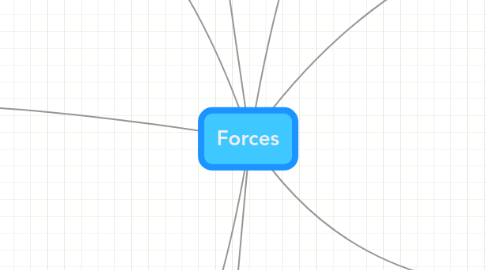
1. Newton's Laws
1.1. 1st Law
1.1.1. The Law of Inertia
1.1.1.1. An object's velocity does not change if and only if the net force acting on the object is zero. (page 29)
1.2. 2nd Law
1.2.1. F=ma
1.2.2. more in Ch. 3
1.3. 3rd Law
1.3.1. Interaction Pairs
1.3.1.1. interaction between two objects will exert force on the other.
1.3.1.1.1. Internal interactions
1.3.1.1.2. External interactions
1.3.1.2. These forces are equal inmagnitude and opposite in direction
1.3.1.2.1. Gravitational Forces
2. Vectors
2.1. Magnitude
2.1.1. the speed at which the objects moves
2.2. Direction
2.2.1. direction of motion
2.2.2. always physical direction in space
2.3. Quantities
2.3.1. Scalar
2.3.1.1. Mass
2.3.1.2. has magnitude, algebraic sign, and units but no direction in space
2.3.1.3. Temperature
3. Problem Solving
3.1. Net Force
3.1.1. Vector sum of all the forces acting on an object
3.2. Free Body Diagrams
3.2.1. Simplified sketch
3.2.2. A single object with all the force vectors acting on that object
3.3. Vector addition
3.3.1. Tail to tip method
3.3.2. Finding components of a vector
3.3.2.1. draw right triangles
3.3.2.2. equations
3.3.2.3. add all the components
3.3.2.4. Sin/Cos/Tan
4. Friction
4.1. Static Friction
4.1.1. acts on objects to prevent them from moving
4.1.1.1. A car stopped on a hill
4.1.1.2. a bathroom mat in the shower
4.2. Kinectic Friction
4.2.1. when two objects are slipping and sliding across one another
4.2.1.1. Earth plates
4.2.2. acts on the object to get it to stop
5. Tension
5.1. pulls on an object in opposite directions
5.1.1. a chandelier hanging from the ceiling
5.1.1.1. A force hanging it up (the cord)
5.1.1.2. the force of gravity pulling it down
5.2. Tensile forces
5.2.1. Body
5.2.1.1. biomechanics
5.2.1.1.1. tendons/muscles
5.2.1.1.2. bones
5.3. Pulleys
5.3.1. ideal pulleys
5.3.1.1. no mass
5.3.1.2. no friction
5.3.1.3. can change the direction of the force exerted on an object
5.3.1.4. does not change magnitude
5.3.1.5. chains/chords/cables
6. Different Types
6.1. Long range Forces
6.1.1. Gravity
6.1.1.1. gravity of the planets is an example
6.1.2. Weight
6.1.3. Do not require forces to touch
6.2. Normal forces
6.2.1. a book sitting on a table is an example
6.2.2. equal
6.3. Contact Forces
6.3.1. A force exerted on another force.
6.3.2. The Contact force only last as long as the objects are touching.
6.4. Equilibrium
6.4.1. conveys the idea that the forces are in balance
6.4.2. The net force is zero
6.5. Fundamental forces
6.5.1. Electromagnetism
6.5.1.1. field is unlimited
6.5.1.2. electrical charge
6.5.1.3. stronger than gravitational force
6.5.2. Gravitational Forces
6.5.2.1. Newton's laws of gravitational forces
6.5.3. The strong force
6.5.3.1. holds protons and neutrons together
6.5.3.2. The strongest of all forces
6.5.4. The weak force
6.5.4.1. radioactive decay process
6.6. Interactions
6.6.1. Internal
6.6.1.1. Both objects are interacting on the system
6.6.2. External
6.6.2.1. When only one object is interacting on the system
7. Defintition
7.1. A push or a pull on an object
8. Words of the Day
8.1. Ramp-up
8.1.1. build up and strengthen skills in physics
8.2. Chains
8.2.1. tension forces and gravity
8.3. Link-up
8.3.1. put together everything you have learn so far
8.4. Elan
8.4.1. Vigorous spirit and enthusiasm
